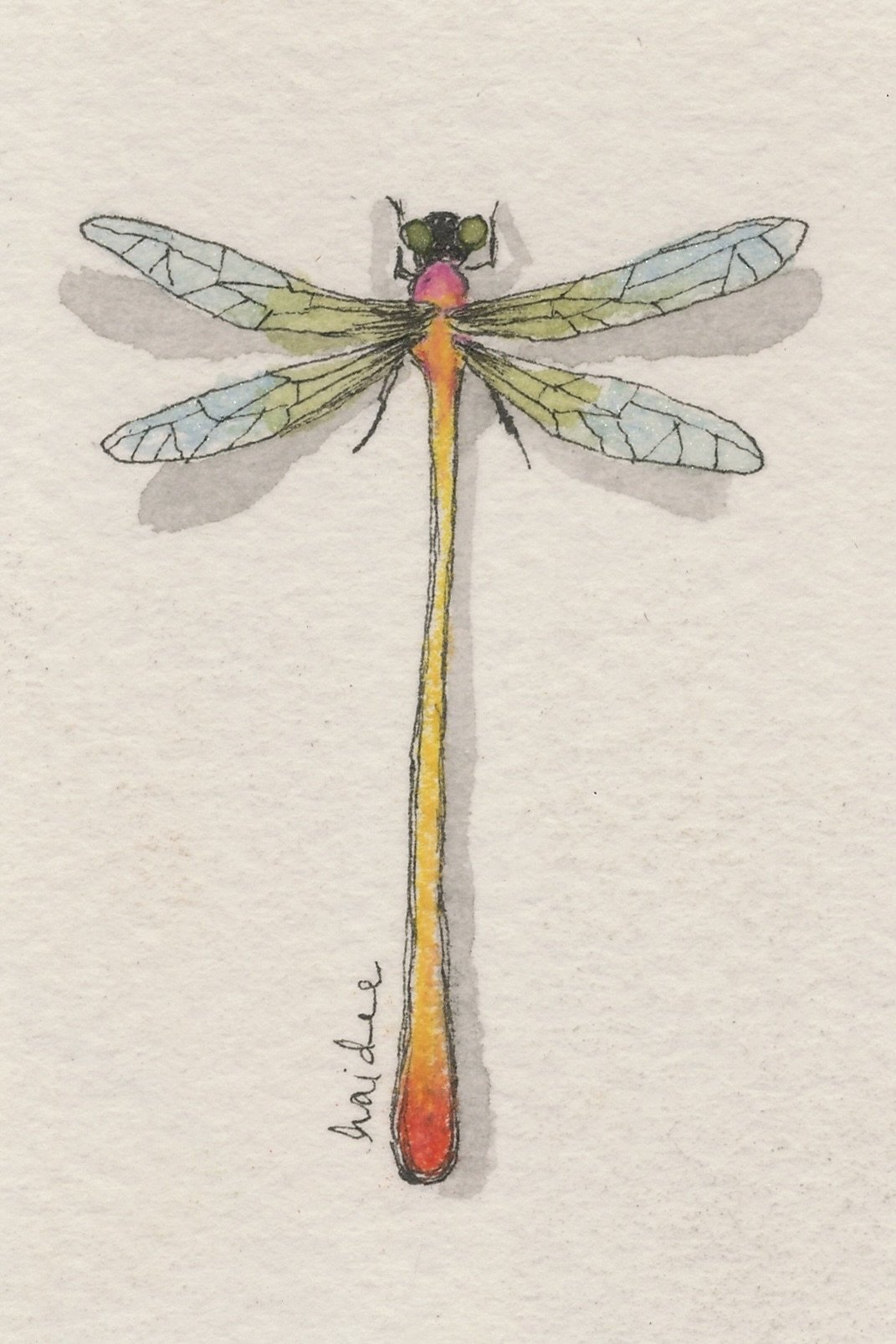 Image 1 of 2
Image 1 of 2

 Image 2 of 2
Image 2 of 2



Specimen No. 14. Small Flame-Tipped Ribbon
Specimen No. 14
Caudoluma aureoflamma
Common Name: “The Flame-Tipped Ribbon”
Collected: 1883, Floating Reeds Preserve, Caldas District, Colombia
By: Inez Maranta, botanical illustrator and independent field researcher
In the great pantheon of airborne insects—sleek damselflies, meadow spinners, crest-winged dusk gliders, and the storied emerald darners of the northern marshes—few are as subtle and arresting as Caudoluma aureoflamma, more poetically known as The Flame-Tipped Ribbon.
Its wings, all but invisible, shimmer faintly with a veil of pale mint and glacier-washed blue. In sunlight they catch a whisper of color, like glass fogged by breath or morning dew on a reed. These wings are delicate, yes—but deliberate—allowing the insect to drift, hover, and veer with a grace almost too perfect for a creature so ancient.
But it is the abdomen that marks this specimen as extraordinary: an impossibly long, tapering tail that begins in muted lemon-yellow and ends in a sudden, brilliant flare of orange. In motion, it reads as flame—fluttering behind the dragonfly like a filament of sunset unraveling through air.
Inez Maranta, who discovered this specimen during her solo work in the wetlands of Caldas, believed at first it was not a new species but a mirage cast by late-afternoon light. She later referred to it as El Hilo de Sol—“The Thread of Sunlight”—and posited in her illustrated notes that it may have evolved in visual conversation with the giant darners that shared its territory. Where those were armored and electric, this one was ethereal and incandescent—a counterpoint to force, a thread of poetry gliding through their thunder.
Though long elusive to taxonomists, the species has earned its place in entomological lore alongside blue-tipped meadow darts, the shadowy spinners of the Pyrenees, and the regal crest-bodied flyers now colloquially referred to as “Daenerys-types” for their improbable elegance and impossible tailwork.
Framed beneath archival acrylic in a hover posture, Specimen No. 14 captures a rare moment: that sliver of day when everything slows, and the air holds something luminous and ungraspable.
It is not just a dragonfly—it is the memory of light.
Note: High quality archival glicée print on acid-free paper, a method that creates fine art reproductions with exceptional color accuracy and longevity. Pigments-based inks are designed to resist fading and discoloration and capture the finest details and subtle color variations with great precision.
Housed in a 4×6” crystal-clear acrylic specimen block, its 1” depth allows freestanding display. Each piece is designed to exhibit on desk, shelf, or wall.
Fly Design uses a practice known as entonology — the study of fictitious insects — to reimagine the natural world through scientific storytelling and poetic design.
Specimen No. 14
Caudoluma aureoflamma
Common Name: “The Flame-Tipped Ribbon”
Collected: 1883, Floating Reeds Preserve, Caldas District, Colombia
By: Inez Maranta, botanical illustrator and independent field researcher
In the great pantheon of airborne insects—sleek damselflies, meadow spinners, crest-winged dusk gliders, and the storied emerald darners of the northern marshes—few are as subtle and arresting as Caudoluma aureoflamma, more poetically known as The Flame-Tipped Ribbon.
Its wings, all but invisible, shimmer faintly with a veil of pale mint and glacier-washed blue. In sunlight they catch a whisper of color, like glass fogged by breath or morning dew on a reed. These wings are delicate, yes—but deliberate—allowing the insect to drift, hover, and veer with a grace almost too perfect for a creature so ancient.
But it is the abdomen that marks this specimen as extraordinary: an impossibly long, tapering tail that begins in muted lemon-yellow and ends in a sudden, brilliant flare of orange. In motion, it reads as flame—fluttering behind the dragonfly like a filament of sunset unraveling through air.
Inez Maranta, who discovered this specimen during her solo work in the wetlands of Caldas, believed at first it was not a new species but a mirage cast by late-afternoon light. She later referred to it as El Hilo de Sol—“The Thread of Sunlight”—and posited in her illustrated notes that it may have evolved in visual conversation with the giant darners that shared its territory. Where those were armored and electric, this one was ethereal and incandescent—a counterpoint to force, a thread of poetry gliding through their thunder.
Though long elusive to taxonomists, the species has earned its place in entomological lore alongside blue-tipped meadow darts, the shadowy spinners of the Pyrenees, and the regal crest-bodied flyers now colloquially referred to as “Daenerys-types” for their improbable elegance and impossible tailwork.
Framed beneath archival acrylic in a hover posture, Specimen No. 14 captures a rare moment: that sliver of day when everything slows, and the air holds something luminous and ungraspable.
It is not just a dragonfly—it is the memory of light.
Note: High quality archival glicée print on acid-free paper, a method that creates fine art reproductions with exceptional color accuracy and longevity. Pigments-based inks are designed to resist fading and discoloration and capture the finest details and subtle color variations with great precision.
Housed in a 4×6” crystal-clear acrylic specimen block, its 1” depth allows freestanding display. Each piece is designed to exhibit on desk, shelf, or wall.
Fly Design uses a practice known as entonology — the study of fictitious insects — to reimagine the natural world through scientific storytelling and poetic design.